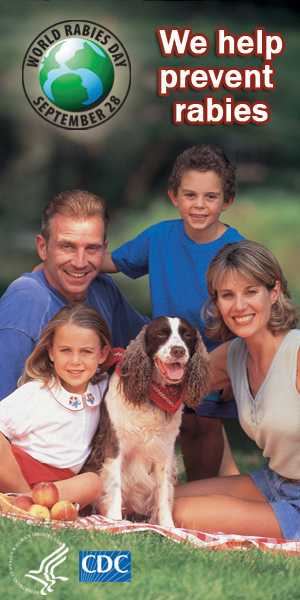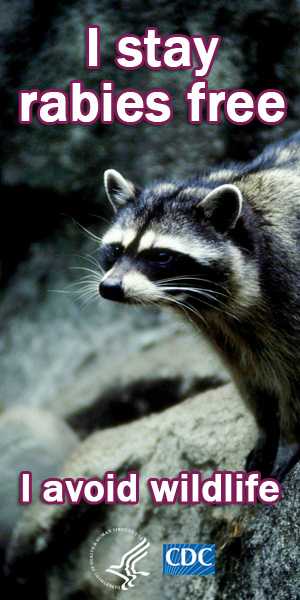Multimedia
On This Page
Emerging Infectious Diseases: Rabies in Captive Deer

Dr. Brett Petersen, a medical officer at CDC, discusses rabies in captive deer. Created: 4/30/2012 by National Center for Emerging and Zoonotic Infectious Diseases (NCEZID). Date Released: 4/30/2012.
Emerging Infectious Diseases: Terrestrial Rabies and Human Postexposure Prophylaxis, New York, USA

This podcast describes a 10-year study of the use of postexposure prophylaxis (PEP) for rabies in New York State. CDC’s Dr. Brett Petersen discusses the prevalence of rabies in the United States and how the study lends support to recent changes in the recommended PEP protocol. Created: 3/15/2010 by National Center for Emerging and Zoonotic Infectious Diseases (NCEZID). Date Released: 4/15/2010.
Emerging Infectious Diseases: Rabies Elimination in Dogs in the United States

Rabies has been eliminated from dogs in the United States through efforts to promote annual vaccination, but it’s still a problem in wildlife in the U.S. and in wild and domesticated animals abroad. In this podcast, CDC’s Dr. Charles Rupprecht discusses a study which provides proof of the elimination of rabies in dogs and what this means for the average American. Created: 12/1/2008 by Emerging Infectious Diseases. Date Released: 12/1/2008.
Ask CDC Rabies

This podcast answers a listener’s question about rabies. Created: 9/28/2009 by National Center for Health Marketing. Date Released: 9/28/2009.
World Rabies Day

In this podcast, Dr. Charles Rupprecht, Chief of the CDC’s Rabies Program, discusses rabies in the United States and globally. Created: 7/27/2010 by National Center for Emerging and Zoonotic Infectious Diseases (NCEZID). Date Released: 7/27/2010.
Rabies and Risk to Travelers

Each year over 55,000 people die because of rabies, mostly from being bitten by rabid dogs. Over half of all rabies infections occur in children under the age of 15 who live in developing countries, but travelers are not immune. This podcast discusses some of the activities that put travelers at risk for rabies and describes ways to prevent infection. Created: 10/1/2007 by National Center for the Prevention, Detection and Control of Infectious Diseases (NCPDCID).Date Released: 10/5/2007.
Videos
Public Health Grand Rounds: Rabies Elimination in the 21 st Century?
Video opens in new window.
The January 2011 session of Grand Rounds addressed traditional and new approaches to disease prevention and control, the importance of evidence-based strategies and interventions for human prophylaxis and animal control, and discussed current opportunities and challenges in eliminating this disease in both developed and developing countries.
Download Video [WMV – 204MB]
Run time: 01:00:13
Presentation: Rabies Elimination in the 21st Century [PDF – 4.7MB]
Changes to Rabies Vaccine Recommendations
Video opens in new window.
Author: Brett W. Petersen, MD, MPH
Published: 2/22/2011
Note: This video is part of the CDC Expert Commentary series, a collaboration between CDC and Medscape.
Rabies Transmission, Identification, Diagnosis, and Safety
Video opens in new window.
Author: Brett W. Petersen, MD, MPHPublished: 3/31/2010
Note: This video is part of the CDC Expert Commentary series, a collaboration between CDC and Medscape.
Feature Articles & Blog Posts
Feature Articles
World Rabies Day
Featured: September 20, 2010
World Rabies Day is September 28. On this day, begin to take the steps to keep yourself and your family free from rabies. Look for events in your area that provide an opportunity to celebrate World Rabies Day and get the facts on rabies prevention and control.
Rabies and Kids
Featured: August 23, 2010
Rabies is a dangerous virus that is found in the saliva of animals. It can infect and kill animals and humans. Every 10 minutes, someone dies from rabies. Even though anyone can get rabies, more than half of the people who get rabies are kids under the age of 15.
Protect Your Family from Rabies
Featured: July 26, 2010
Rabies is a dangerous virus that anyone can get if they handle or get bitten by an animal that has the disease. Protect yourself and your family from rabies: Stay away from wild animals and be sure pets are vaccinated every year.
Data and Statistics: The Burden of Rabies
Featured: September 27, 2010
In the U.S., rabies represents a serious threat to the health of people and animals. Every year, it is estimated that 40,000 persons receive a rabies prevention treatment called post-exposure prophylaxis (PEP) due to a potential exposure to rabies.
Blog Posts
Global Rabies Control
Posted: September 23, 2013
In this two-part series, rabies program EIS Officer Ryan Wallace describes his travels around the world and how it impacts global rabies prevention and control efforts.
Globe Hopping, Rabies Stopping: Outreach to DRC
Posted: March 3, 2010
We often talk about what we ve done to help others stay free of infectious diseases. But something that often goes unstated is the training we provide that gives other health and medical professionals the tools to keep people healthy. Although a lot of this work happens here in the United States, the assistance we provide to other countries facing overwhelming disease outbreaks is also important.
Imported Human Rabies Cases
Posted: July 15, 2009
In the U.S., human rabies is rare, thanks mostly to the availability of rabies vaccination and the elimination of dog rabies. But in many other countries around the world, dog rabies is very common and people are at greater risk. When a person travels or immigrates from an area of higher risk (like Mexico) to an area of lower risk (like the United States), they may encounter obstacles in getting diagnosed correctly if they have rabies. A recent human rabies case from California demonstrates the challenges that can arise when attempting to administer care to a person from another country.
Badges/Buttons
- Page last reviewed: May 8, 2012
- Page last updated: September 25, 2013
- Content source:





 ShareCompartir
ShareCompartir











